Best Things to Do in Quy Nhon and Binh Dinh – Underrated Destinations in Vietnam
Quy Nhon is a coastal city located in Binh Dinh Province in Central Vietnam, a region with beautiful beaches and a rich history. We highly recommend a visit to this area, especially if you are interested in exploring off-the-beaten-path destinations. In this article, you will discover a list of things to do in Quy Nhon and Binh Dinh that truly distinguish this region from other well-known locations in Vietnam.
Overview
Bình Định Province, located in the South Central Coast of Vietnam, is a region with a rich and intriguing history. It was once the center of the ancient Champa civilization, and relics from this era still dot the landscape. In addition, Binh Dinh was where the Tay Son rebellion originated in the late 18th century. It was a significant and transformative period in Vietnamese history.
The provincial capital, Quy Nhơn, is a coastal city with a picturesque coastline and serene beaches. Over the past few years, Quy Nhơn has witnessed a significant rise in its domestic tourism as more Vietnamese people, especially the younger generations, seek out authentic experiences and less commercialized destinations to explore.
We finally had a chance to spend 4 days in Quy Nhon recently and it was among one of our most favorite trips in Vietnam this year, besides our Lan Ha Bay overnight cruise. Its beaches are among the clearest in Vietnam, and we also appreciate the opportunity to delve into our country’s history again after forgetting most of the history lessons taught at school.
Quy Nhon and Binh Dinh still remain relatively little known outside of Vietnam. Thus, we are eager to share all the attractions and activities there to inspire you. It’s definitely up there with Da Nang, Hoi An, Nha Trang, and much better than Phu Quoc in our opinion. Binh Dinh and Quy Nhon are definitely worth a visit.
Historical and Cultural Sites
Champa Towers
The Champa towers in Bình Định are significant remnants of the ancient civilization, which thrived in parts of Central and Southern Vietnam from the 2nd to the late 15th century. These towers are religious structures built primarily of red bricks, and they showcase the architectural, cultural, and spiritual legacy of the Cham people. Their craftsmanship was so meticulous that it is impossible to find the mortar between bricks.
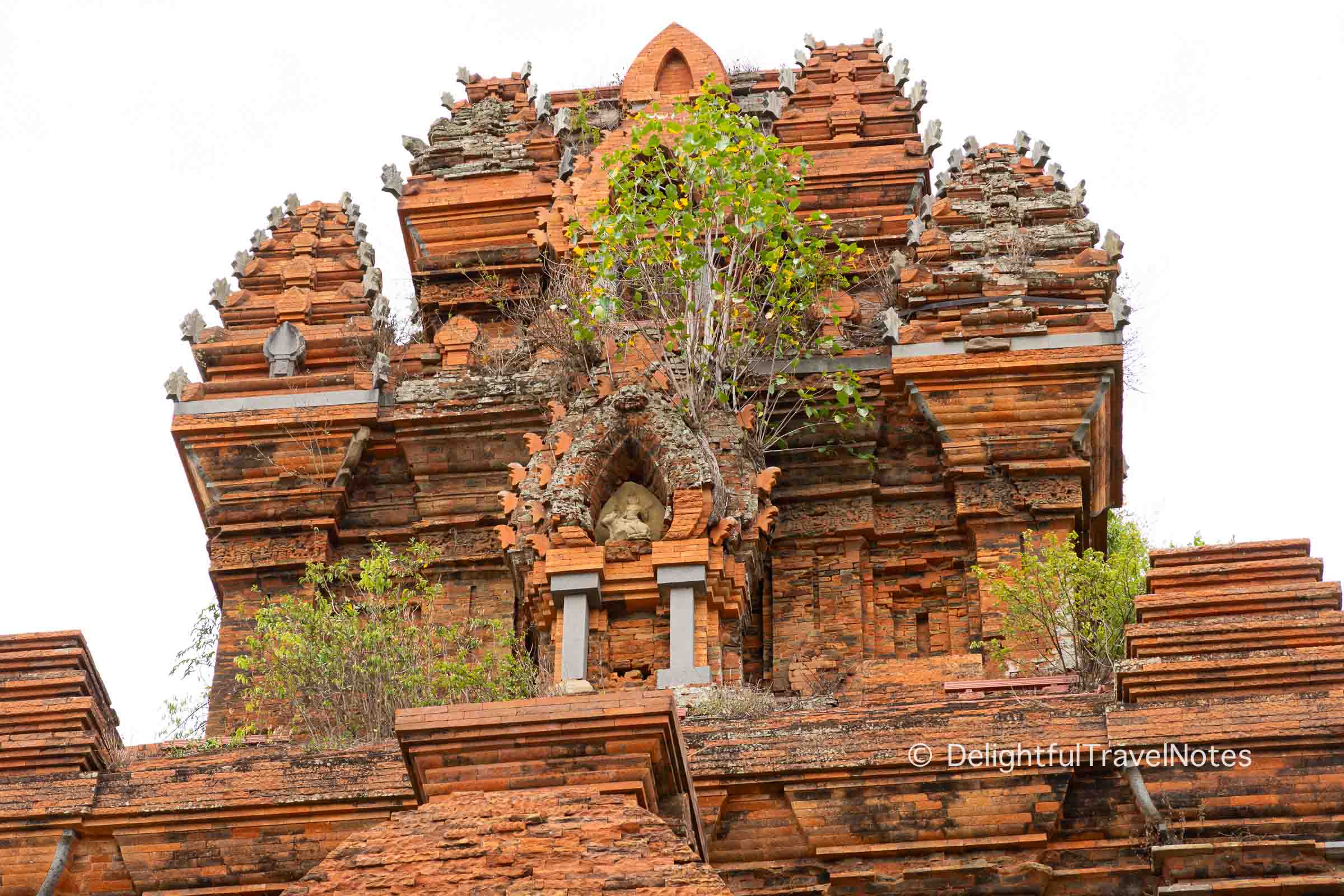
The Cham towers were usually built on elevated platforms, lending prominence to the structure. These towers were oriented toward the east, facing the sunrise, which is a characteristic they share with many Hindu temples in India. They often feature intricate carvings and bas-reliefs depicting Hindu deities and other mythical creatures.
A few of Champa towers still remain in Binh Dinh, and each of them has its own distinguishing features. If you have time, we highly recommend visiting at least 2-3 of them. Compared to the Cham temples at My Son Sanctuary, the ones in Binh Dinh are generally in a better condition.
Banh It Towers
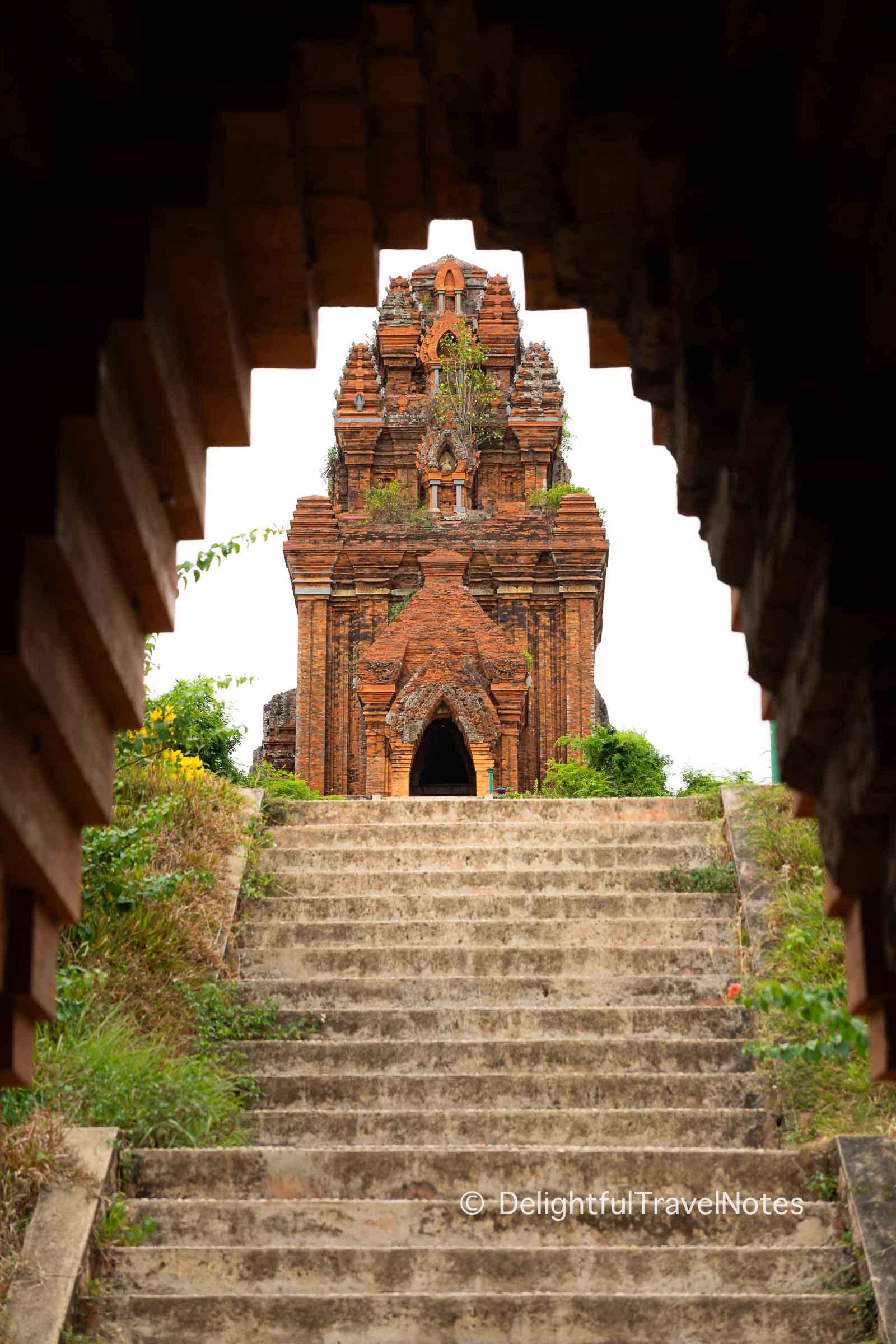
Banh It is perhaps the most famous group of Champa towers in the province. Their construction is believed to have taken place around the 11th-12th centuries. The complex consists of several towers, with the main tower sitting on a hill. The top part of the main temple has been inhabited by bats, so the odor is very strong inside.
The artistic style of this Champa temple complex belongs to the transition period, from My Son A1 style which features delicate and elegant carvings on the tower body to Binh Dinh style which focuses on blocks and scale and features fewer decorative motifs. Besides, in Binh Dinh style, the arch door rises up to form a spearhead shape.
There are quite a few steps leading up to the Banh It towers, but the path is well-paved and nothing is too challenging. The site offers many great photo opportunities if you are into photography.
Duong Long Towers
Similar to other Cham complexes, the Dương Long Towers comprise several structures. There are three towers aligned on a north-south axis with the tallest one rising to a height of about 42 meters. This makes it one of the tallest Cham structures still standing.
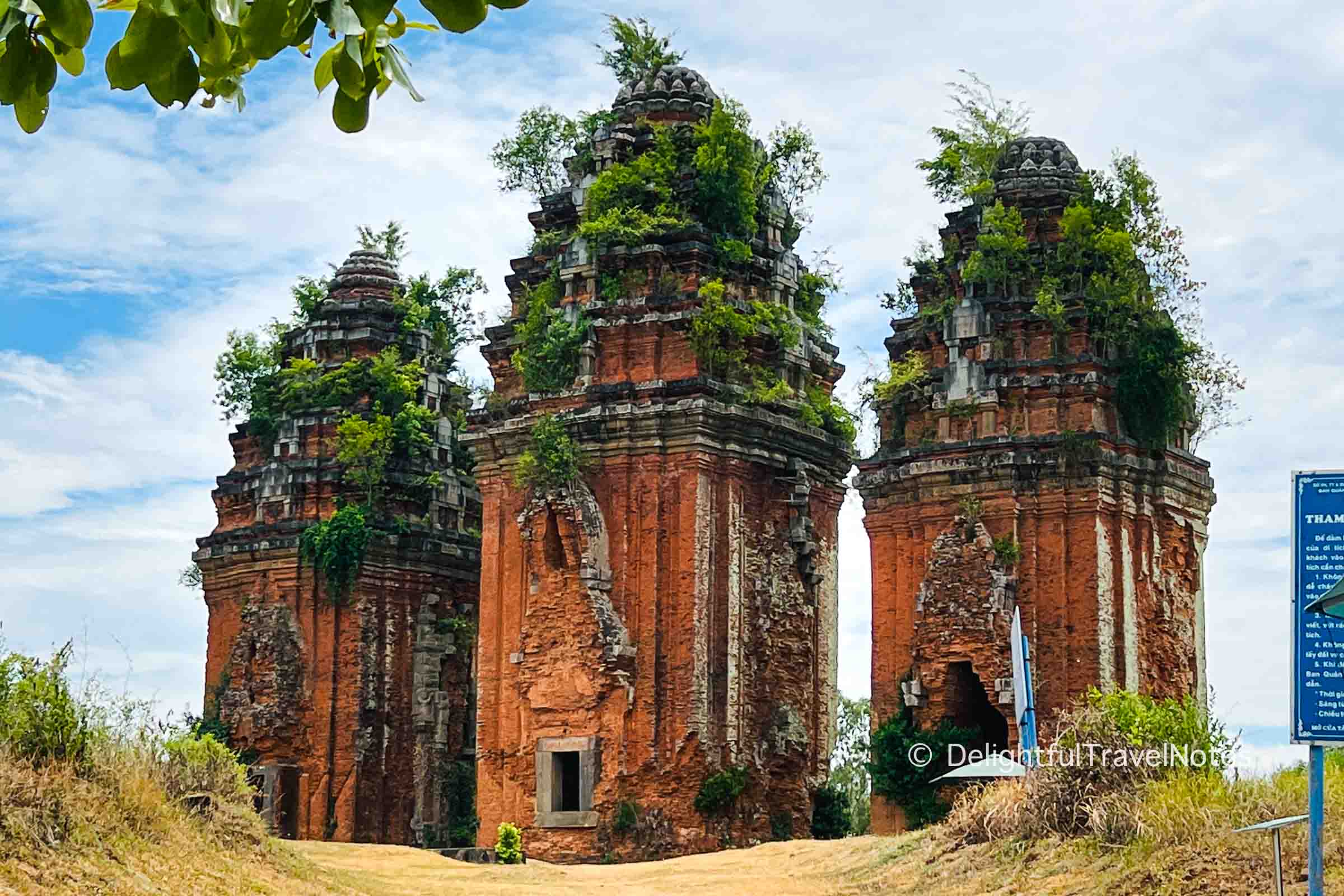
The Dương Long Towers date back to the late 12th century and early 13th century. These towers belong to Binh Dinh style, judging from the spearhead shaped arch and the lack of decorative motifs on their pilasters.
Last year, the province approved a budget for restoration and conservation to maintain the towers and prevent further degradation. While they might not receive as many visitors due to their remote location, we found them to be pretty impressive. One thing to note is the site is closed at noon until early afternoon, so plan your visit to avoid disappointment.
Thap Doi Towers
Tháp Đôi Towers, also known as the Twin Towers or Double Towers, are centrally located in Quy Nhơn city. This prime location makes them the most accessible Cham towers for visitors in the area.
As the name suggests, Tháp Đôi consists of two brick towers constructed side by side during the late 12th century. Both tower are in Binh Dinh styles, evident by the spearhead-shaped arches and the lack of decorative patterns on the pilasters.
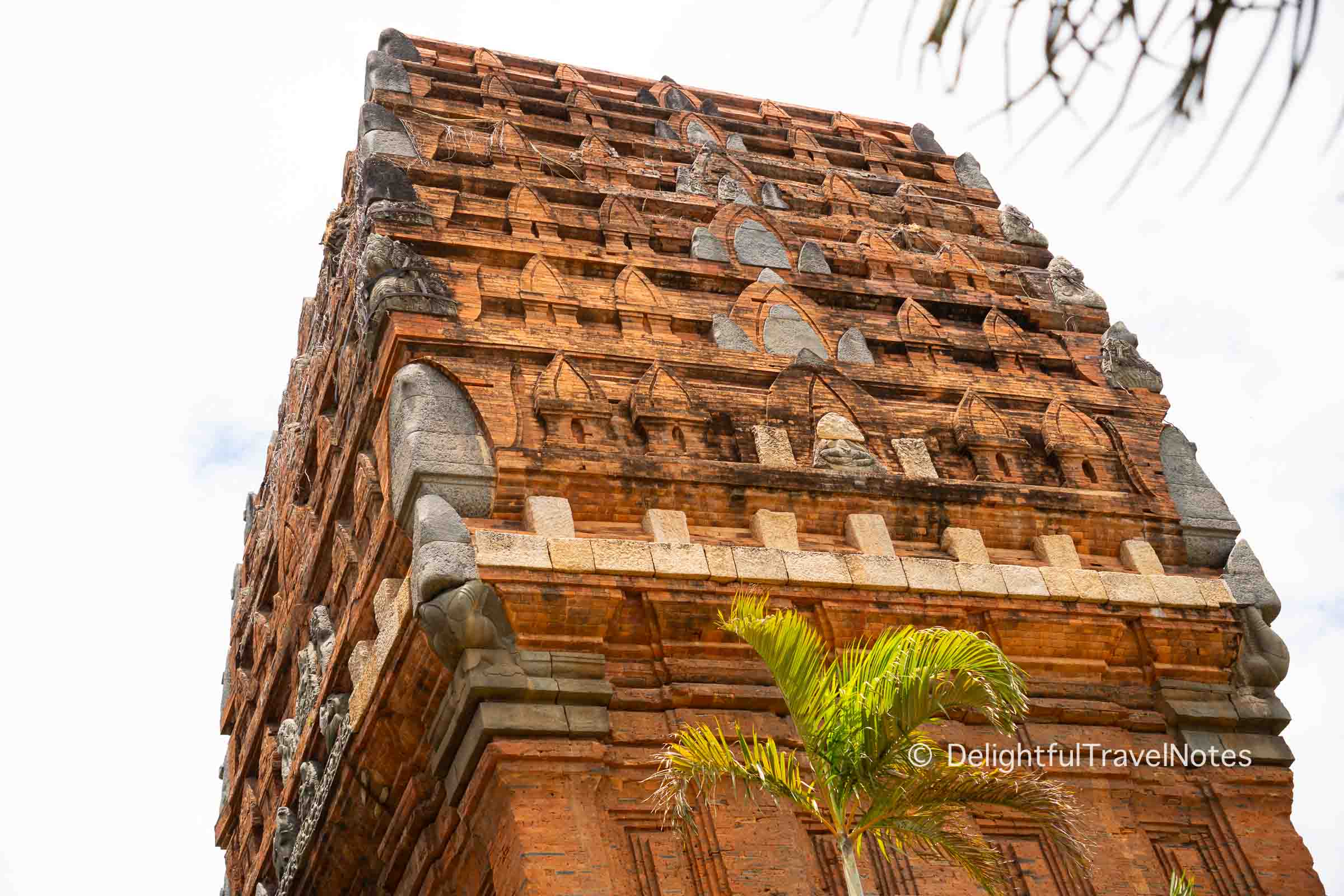
This set of towers are relatively well-preserved and maintained. However, you can quite easily tell apart the original sections and the renovated parts upon close observation. If we have to choose, we will prioritize Banh It Towers and Duong Long Towers over Thap Doi.
If you want to have a deeper understanding of these ancient structures, I recommend reading my article about the different art styles of Champa temples.
Quang Trung Museum
Quang Trung Museum is located in Tây Sơn District, Bình Định Province. The museum is dedicated to Emperor Quang Trung (Nguyễn Huệ), the national hero, and the Tây Sơn rebellion. In the late 18th century, Nguyễn Huệ led the Tây Sơn army to numerous victories against both domestic and foreign adversaries, most notably defeating the Qing invaders.
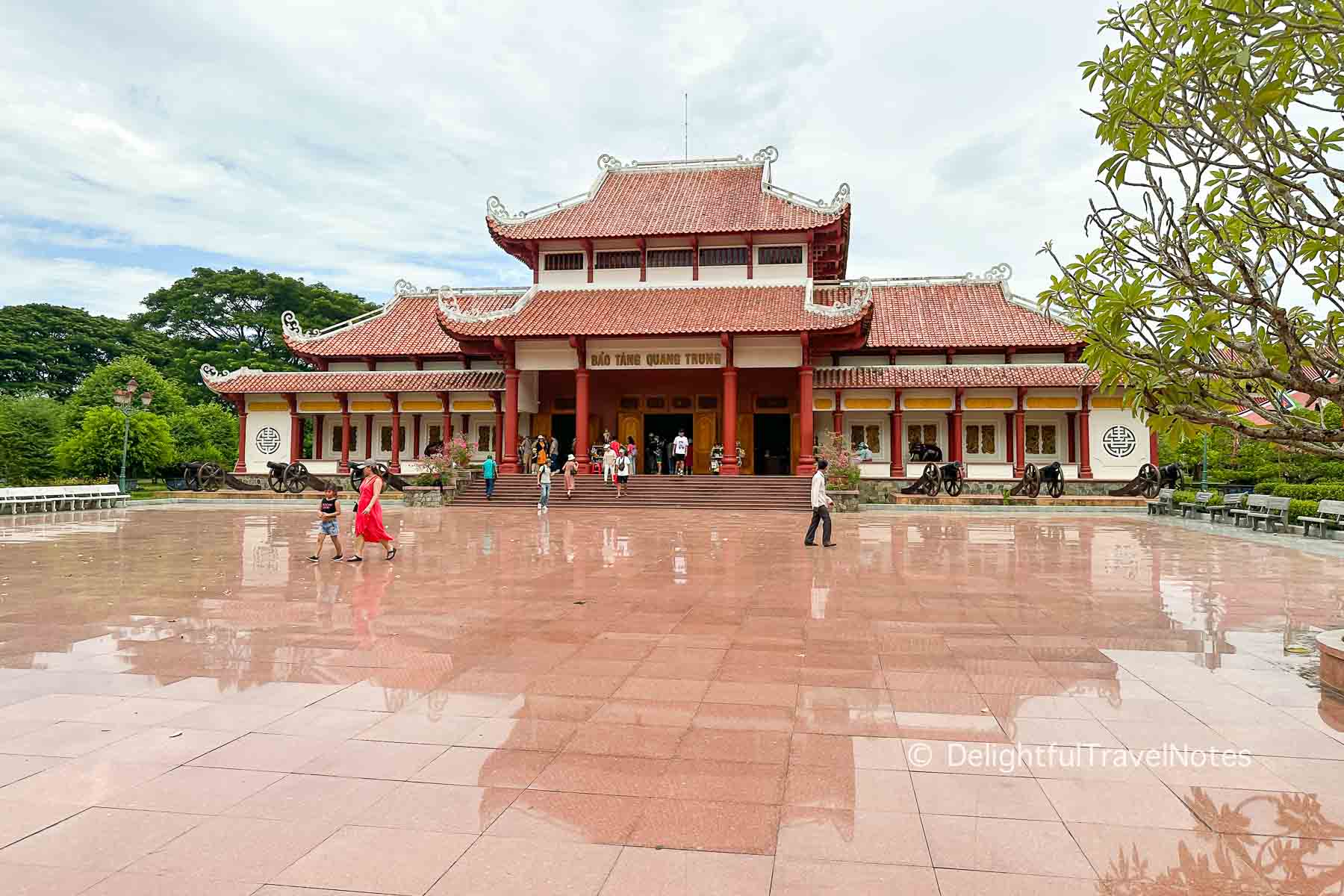
The main hall contains artifacts, paintings, and exhibits highlighting significant events of the Tây Sơn dynasty and pivotal battles under Quang Trung’s leadership. Although the museum failed to provide a comprehensive picture of the period, omitting certain aspects, we think it is worth a visit for history enthusiasts. Many foreign visitors are familiar only with the Vietnam War while Tay Son era is also one of the most significant periods in Vietnamese history. We recommend combining the trip to the museum with a stop at Duong Long Champa Towers.
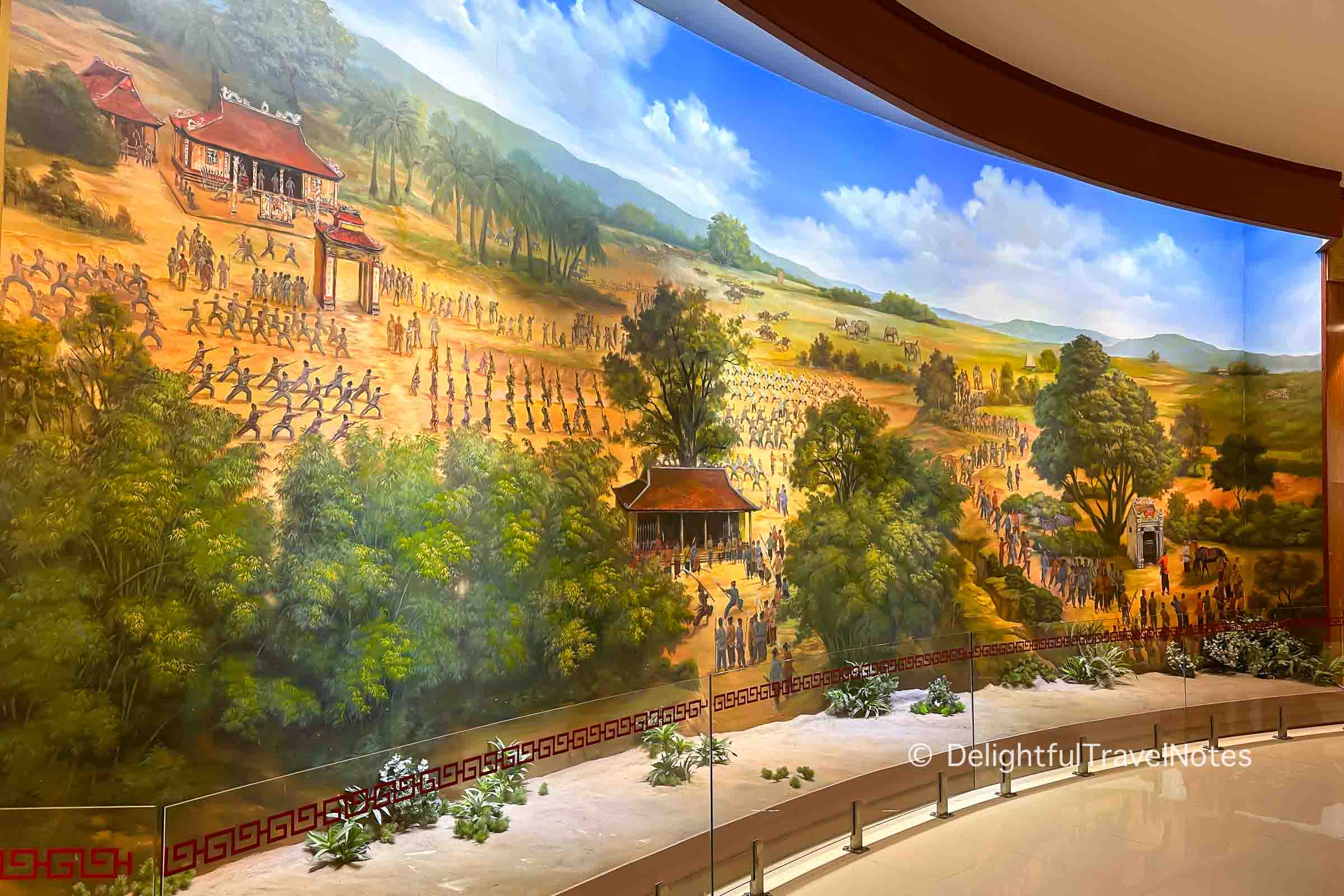
Lang Song Church
Làng Sông Church is approximately 30 kilometers north of Quy Nhơn city. It was built in the late 19th century, showcasing an impressive blend of Gothic architectural elements and French design features. The site used to house Làng Sông printing house, one of the first three printing houses in Vietnam to publish books in the Vietnamese script (chữ quốc ngữ).
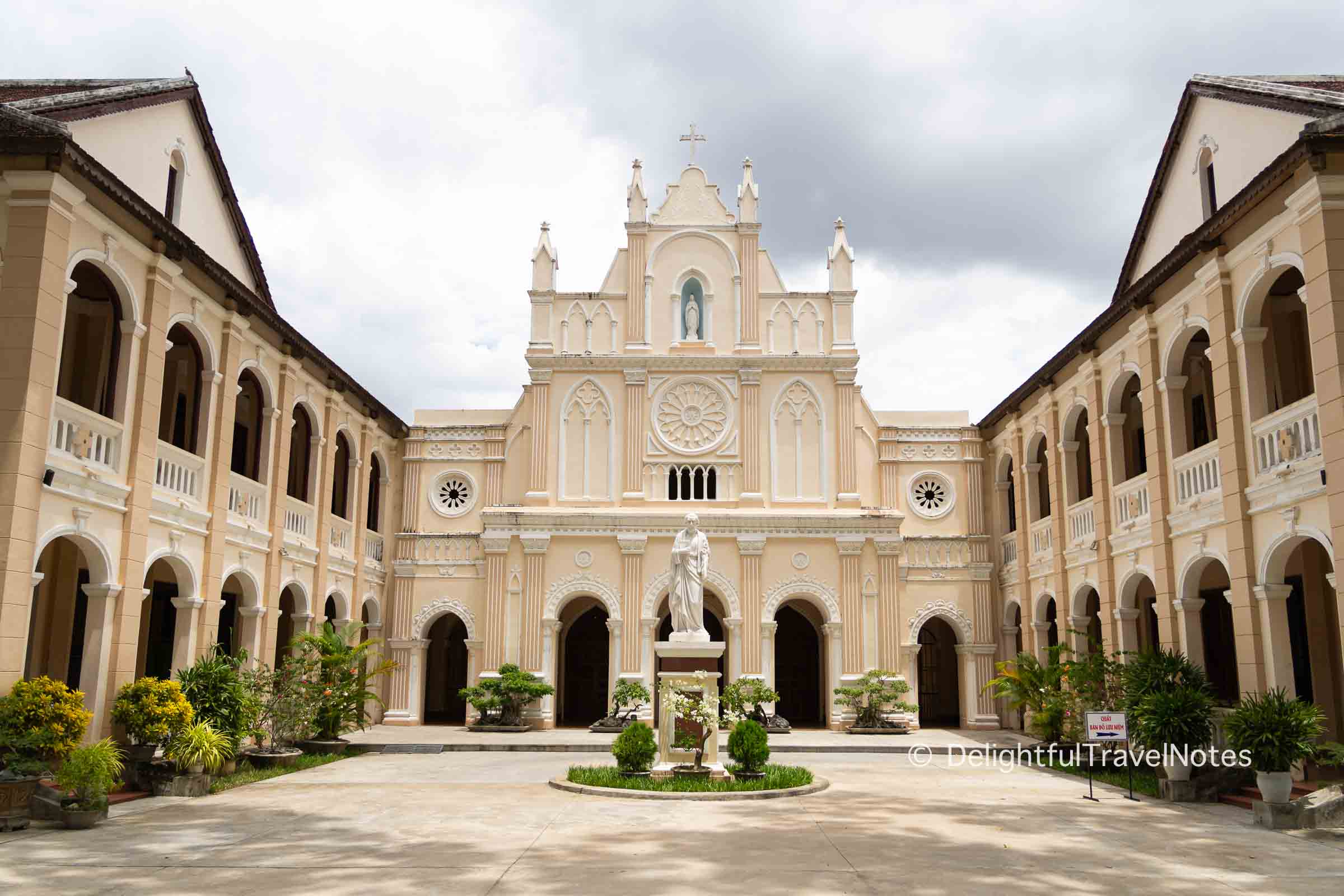
The chapel is built in the Gothic style, featuring three main doors facing the south, and intricately carved doors on both the east (8 doors) and west sides (8 doors). Symmetrically adjacent to the chapel are two rows of two-story buildings constructed in the French architectural style. These buildings have arched windows on the balconies, long corridors, and aligned columns.
It’s true there are not a ton to do here besides walking around admiring the architecture and the location is a bit out of the way. However, we think Lang Song Church is worth visiting. We totally enjoyed seeing it in person and loved the serene atmosphere. The site also offers excellent photo opportunities.
Linh Phong – Ong Nui Temple
Ong Nui Temple is situated on the slopes of a mountain in Phù Cát District, Bình Định Province. Its distinctive features are a huge Buddha statue sitting atop and 600 hundred steps leading to it. In case you are not confident in your physical state to climb up, you can pay a small fee to a motorbike rider to take you up there.
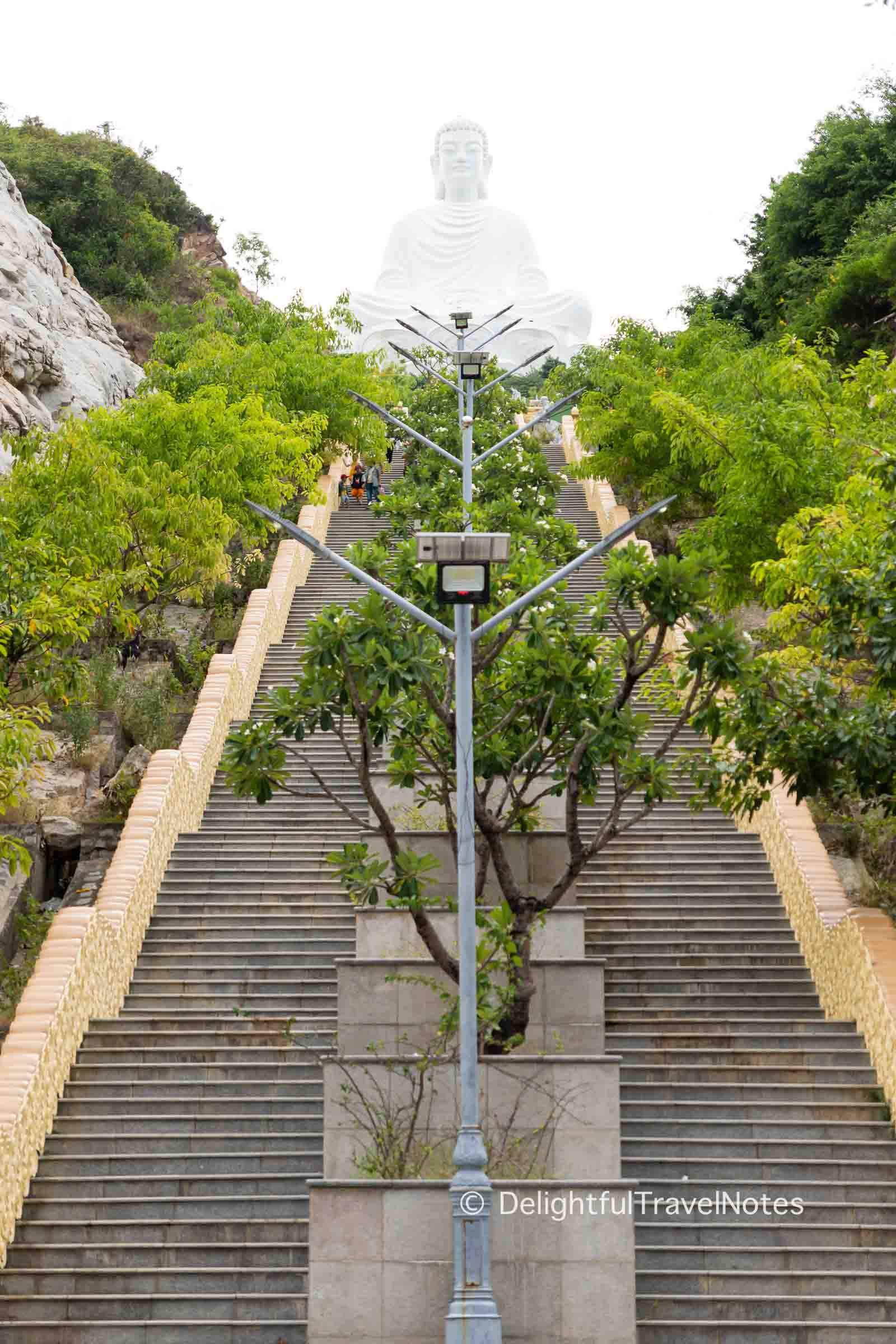
Natural Attractions and Outdoor Activities
Eo Gio
Eo Gio is a coastal area renowned for its unique rock formations, shaped and eroded over time by the power of the sea and wind. These formations create narrow pathways and small inlets, allowing visitors to meander and explore. I think the scenery bears some resemblance to Jeju Island in Korea.
The natural landscape provides numerous spots for photo opportunities. However, due to its rising popularity with domestic tourists, the site is often crowded during weekend and around national holidays. You can consider coming early, especially at sunrise or sunset, to fully enjoy its beauty. We came here on Independence Day, and Eo Gio was full of visitors, as you can see in the photos below.
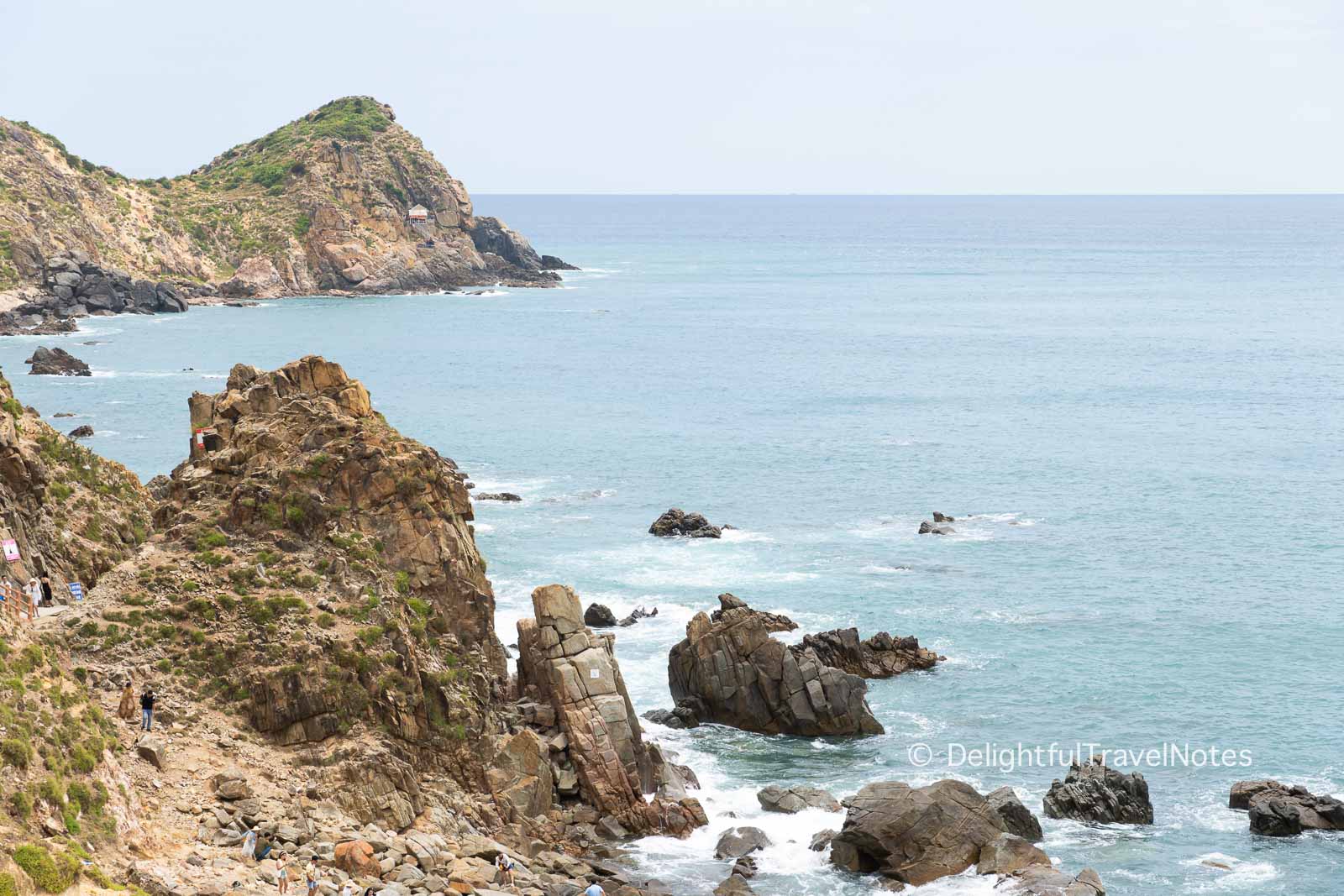

Ky Co Beach
Ky Co Beach is known as one of the most beautiful beaches in the region, and some locals even refer to it as the “Maldives of Vietnam.” It is famous for its long stretch of sandy beach and blue waters. Besides swimming, the beach is also suitable for various water activities, such as jet skiing, boat rides, and snorkeling.
In recent years, with a surge in domestic tourism to Ky Co Beach, the local infrastructure and amenities have developed. There are now several eateries, restrooms, rental services for beach equipment, and many fun spots with props set up for taking photos and selfies.

You can either take a boat or a car ride to Ky Co. Due to its popularity, the beach can get very crowded during national holidays and weekends. I’m glad we went to see it in person, and it was surprisingly fun and amusing to take photos with the props they set up – something we usually don’t do. However, ultimately, I would prefer relaxing on the serene beach at Maia Quy Nhon resort over it.
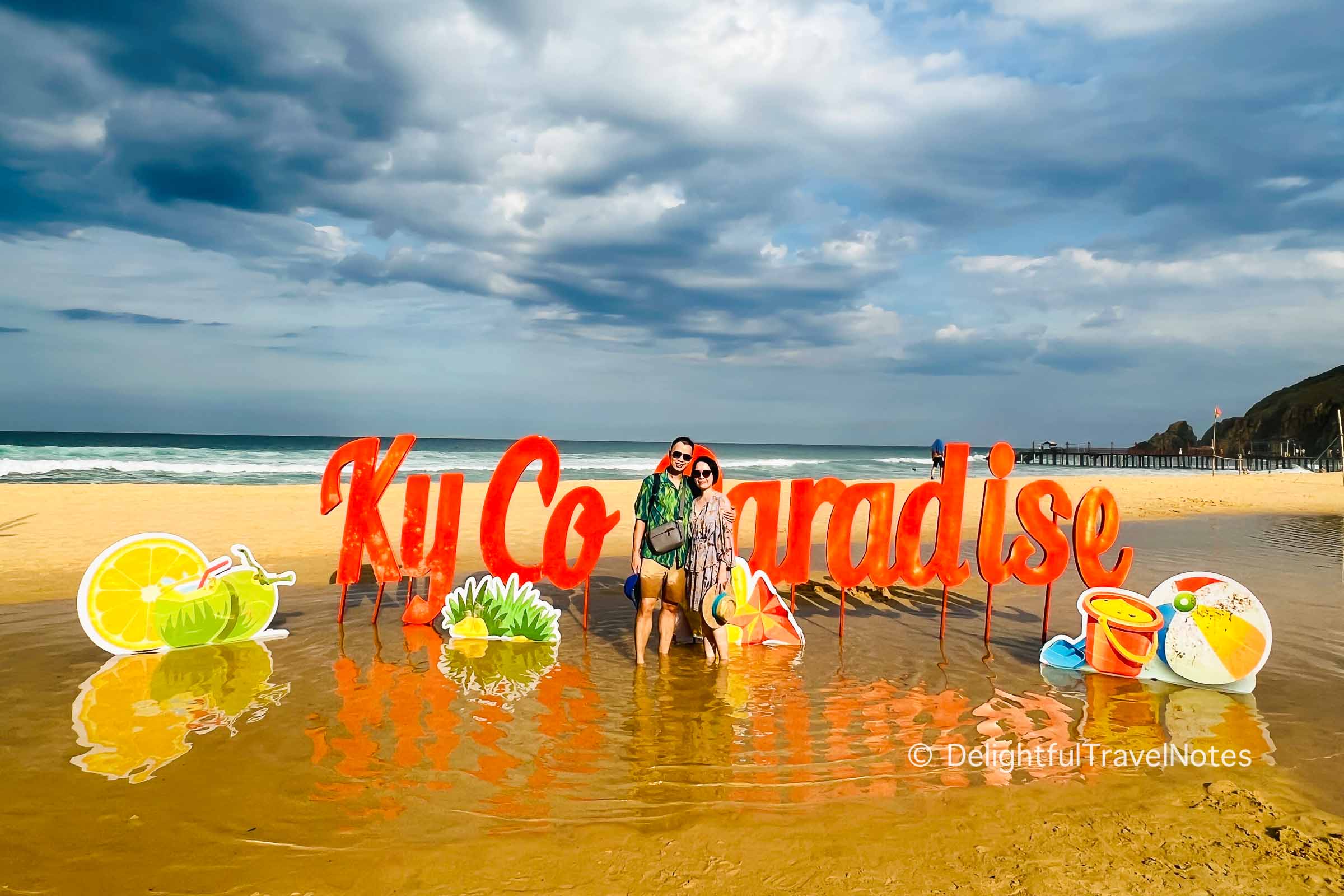
Hon Kho Island and Cu Lao Xanh
These are another two popular sites in Quy Nhon we didn’t have a chance to visit. Both places are known for clear blue waters, and colorful coral reefs.
Cu Lao Xanh is a bit more untouched than Hon Kho. The island features an old lighthouse built during the French colonial period. The lighthouse, apart from being a navigational aid, offers panoramic views of the sea and the mainland from its vantage point.
Hiking/Trekking
Due to being surrounded by mountains, the area also offers a number of hiking opportunities. As mentioned above, both Banh It Towers and Ong Nui Temple provide hikes up the hills. Located near the city center of Quy Nhơn, Vung Chua Mountain provides a relatively easy trek with views of the city and the adjacent coast.
Culinary Experiences
The coastal location of Quy Nhon City and Binh Dinh Province contributes to a diverse range of seafood and traditional local dishes. Compared to some other regions of Vietnam, we find the food here quite balanced, meaning it isn’t overly salty, sweet or spicy. Besides, domestic tourists often praise the affordability and freshness of seafood in Quy Nhon. Here are the local specialties we tried and recommend.
Local Delicacies
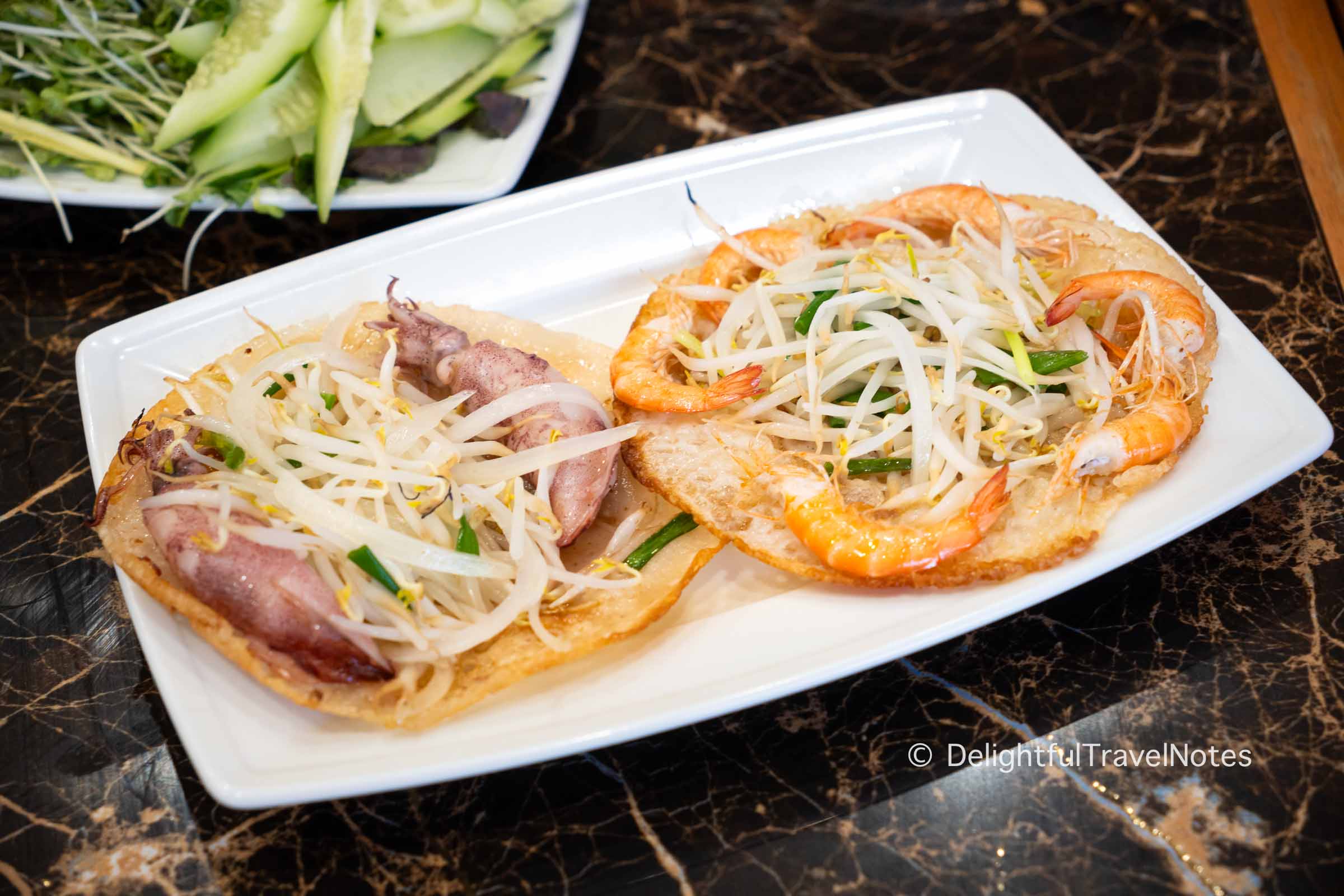
Bánh xèo Bình Định: While bánh xèo (Vietnamese sizzling crepe) is popular throughout Vietnam, the version in Quy Nhon and Binh Dinh is smaller and crispier. It’s typically topped with shrimp or squid, and beansprouts. The crepe is then served open-faced, instead of being folded over like banh xeo in other regions. The version with small shrimp called banh xeo tom nhay is considered a signature dish here.
Chả ram tôm đất: You definitely need to give these mini fried spring rolls a try. Small freshwater shrimp is wrapped with spring roll wrappers, and then fried until crispy. The dish with its crunchy texture and the flavor of tôm đất shrimp will give you a taste of Binh Dinh countryside.
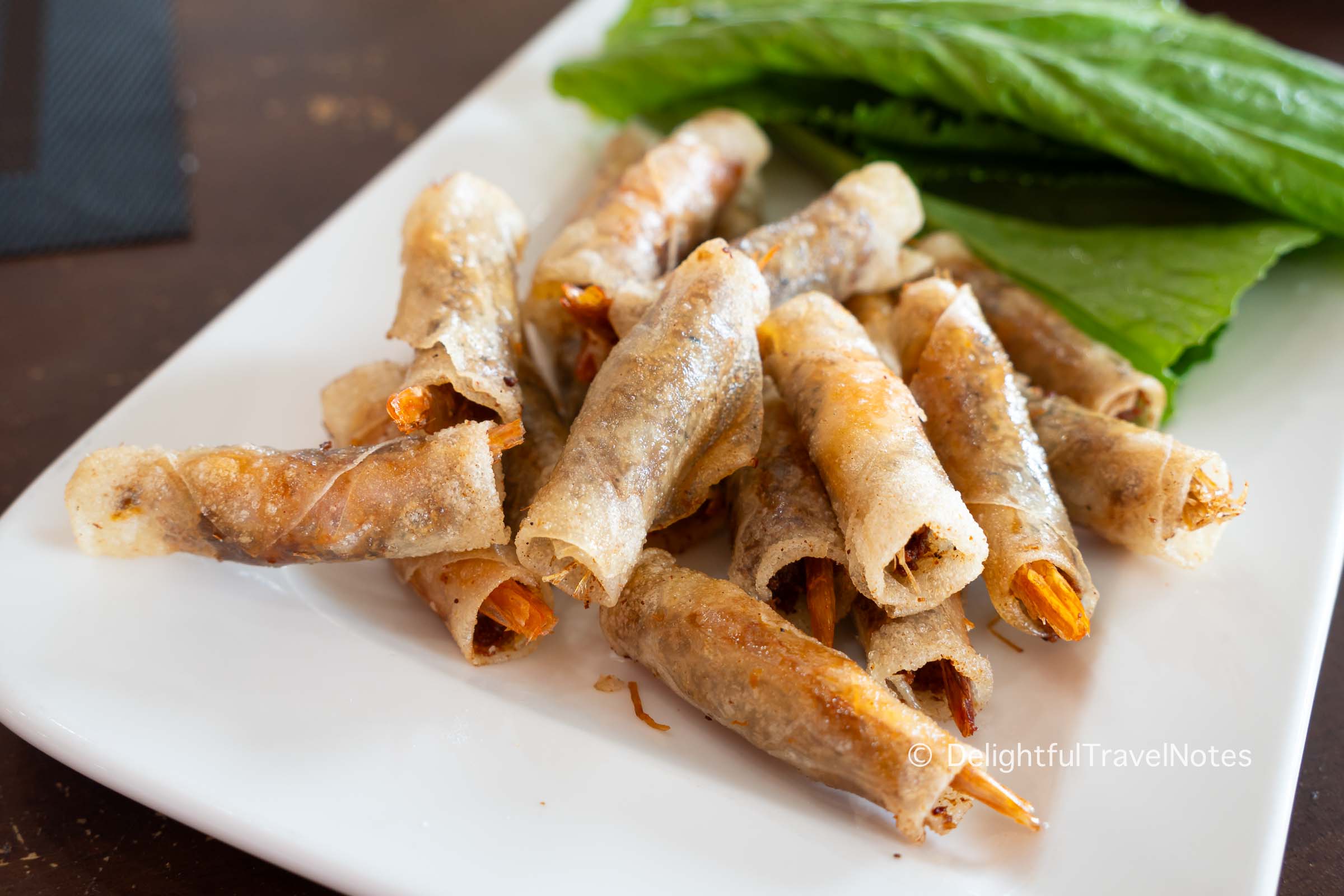
Bánh ít lá gai: These are sticky rice cakes made from glutinous rice colored with a thorny leaf’s extract and filled with mung bean paste and shredded coconut. They are quite fun to eat and not overly sweet. The outside is slightly chewy while the mung bean filling is soft and tender.
Bún chả cá (fish cake rice vermicelli noodle soup): Many coastal towns and cities in Vietnam have their own version of fish cake noodle soups, such as Hai Phong, Da Nang, and Nha Trang. The version in Quy Nhon we tried contains a slice of tuna steaks, fried fish cakes, and a savory and slightly sweet broth. Bun cha ca Ngoc Lien is a famous spot in the city center, and it was packed with locals when we came.
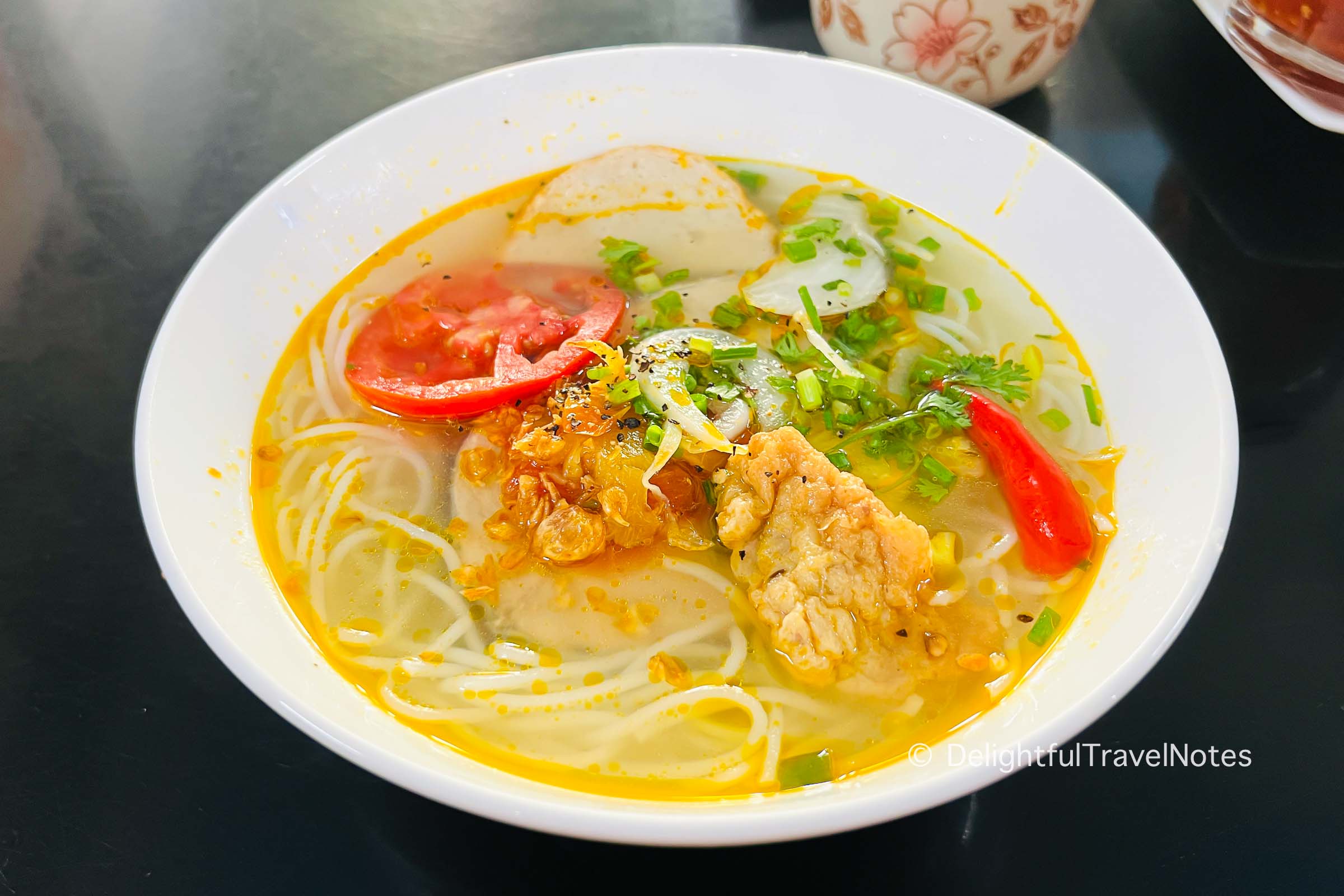
Fresh coconut: Binh Dinh Province is known as one of the primary coconut cultivation hubs in Vietnam. Don’t forget to try fresh coconut juice while you’re here. We always ordered a coconut with every meal and every single one had plenty of refreshing, aromatic, and sweet juice.
Seafood
Being a coastal city, Quy Nhơn is a heaven for seafood fans. Prices are more affordable compared to other popular beach destinations in Vietnam. However, some special seafood may be quoted at market price, rather than a published price printed on the menu.
There are quite a few seafood restaurants around the Eo Gio area. We tried Hoang Thao and the food was decent. In Quy Nhon City, you can find a number of seafood restaurants on Xuan Dieu Street. We had a dinner at 114 restaurant, and although the setting was more casual than Hoang Thao, the food was better executed.
Conclusion
We hope our list of diverse activities and attractions in Quy Nhon and Binh Dinh has inspired you to visit this lesser known part of Vietnam. Here are a couple of places we also visited, and you may consider stopping by if you have extra time:
The tourism industry is still quite new here, so you may not find stellar service or upscale dining yet. English communication can be a bit tricky too since there are very few foreign visitors. However, the region distinguishes itself with its rich history and currently unspoiled natural attractions. We will share a detailed guide and travel tips in the upcoming articles.

Explore More
Best Places to Stay in Hanoi: Not the Old Quarter
Top Must-Try Restaurants in Hanoi – A Local’s Guide
Top 12 Best Vietnamese Restaurants in Ho Chi Minh City – A Local’s Guide